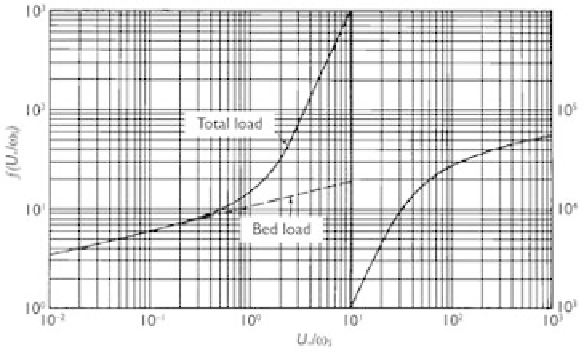Geoscience Reference
In-Depth Information
using the Manning-Strickler equation:
d
50
h
1
/
3
U
2
58
τ
b
=
ρ
(3.104)
in Eq. (3.103) is given as two different curves for bed load
and bed-material load, as shown in Fig. 3.23. Therefore, the Laursen formula can be
used to determine either bed load or bed-material load.
Note that the Laursen formula can provide the sediment concentration for each size
class, but it is generally used to determine only the total sediment concentration. It has
good reliability for fine sediments.
The function
f
(
U
∗
/ω
)
s
Figure 3.23
Function
f
(
U
∗
/ω
s
)
in the Laursen (1958) formula.
Engelund-Hansen formula
Using Bagnold's stream power concept and the similarity principle, Engelund and
Hansen (1967) established the following sediment transport formula:
f
5
/
2
=
0.1
(3.105)
t
s
where
f
is the friction factor, defined as
f
=
U
2
;
gd
3
,
with
q
t
∗
being the bed-material load transport rate by weight per unit time and width;
2
gRS
f
/
=
q
t
∗
/
[
γ
(γ
/γ
−
1
)
]
t
s
is the Shields number
τ
b
/
[
(γ
−
γ)
d
]
; and
d
is the median fall diameter of bed
s
material.
Strictly speaking, the Engelund-Hansen formula should be applied to dune-bed
streams in accordance with the similarity principle. However, many tests have shown
that it can be applied to the upper flow regime with particle size greater than 0.15 mm
(Chang, 1988).



